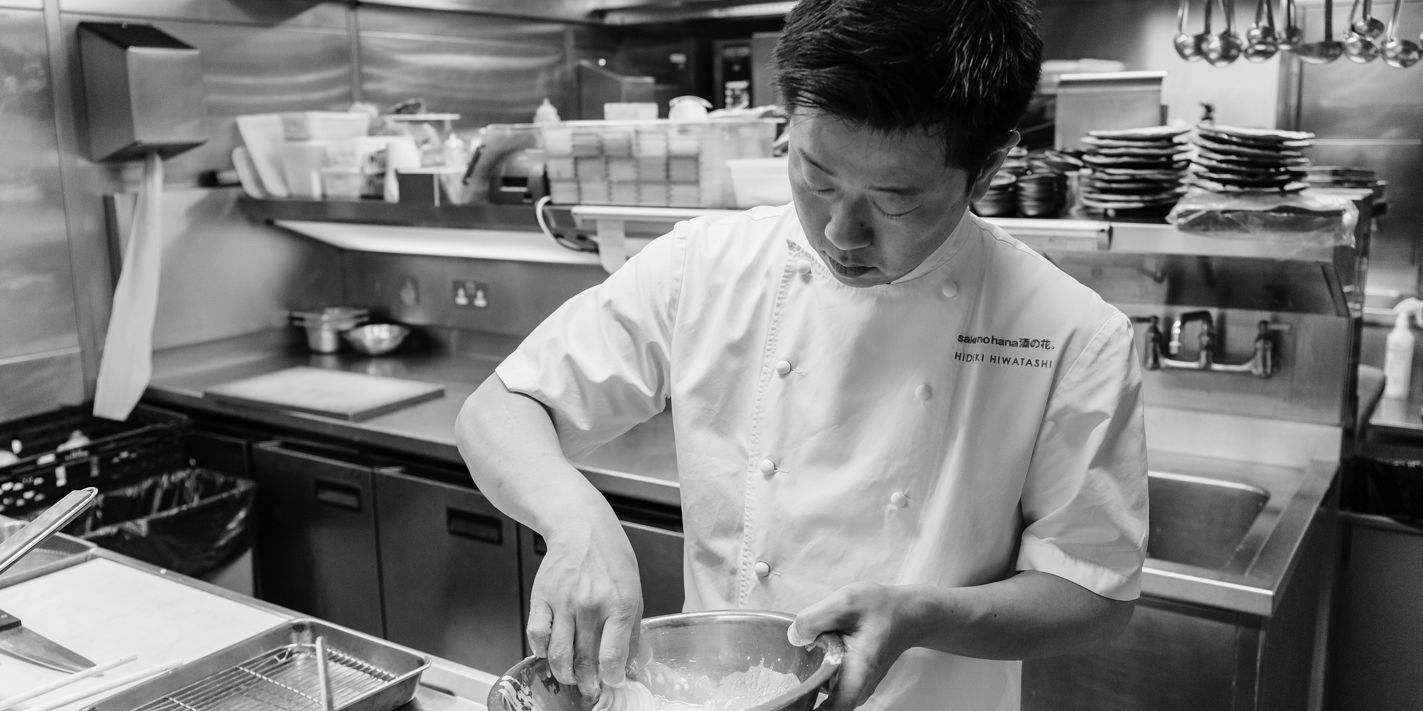Hideki Hiwatashi

Hideki Hiwatashi
With over fifteen years of rigorous Japanese culinary training behind him, Hideki Hiwatashi is well versed in the art of kaiseki cuisine.
Hideki Hiwatashi was born in Tomakomai, a port city in Hokkaido, Japan. His interest in food developed at an early age and, like all good foodies, was inspired by equal parts curiosity and greed. One memory in particular stands out as the moment he knew he wanted to learn to cook. ‘My father took a big pot and put vegetables, chicken bones and pork bones inside to make ramen stock,' he says. 'He put it on the stove and let it cook for maybe two or three days, and the smells filling the house as it slowly cooked were very nice. I kept asking him, ‘When can I eat? When can I eat?’ – it made me interested in food and want to be a chef.’
With this ambition set in his mind, Hideki’s childhood pursuits often involved food in some way – learning from his mum in the kitchen, fishing in the river and diving for scallops and sea urchins in the sea – but the chef was under no illusions as to what the training process for chefs is like in Japan. ‘I knew that the job is incredibly hard, so I didn’t want to do it straight away,’ he says. ‘I thought I’d go somewhere first, see the world, start slowly, then come back to Hokkaido and learn cooking the traditional Japanese way.‘ He travelled a little across America and Australia before settling in Sydney, working at a sushi shop and fish market.
Hideki was offered a more permanent job in Australia but, while he had always dreamed of working abroad, the experience had made him more determined than ever to train in traditional Japanese cooking methods. ‘Even twenty, twenty-five years ago Japanese cuisine was becoming internationally popular, but it wasn’t what you’d call traditional!’ he says. ‘This made me want to learn Japanese cooking the proper way, and take those skills around the world.’
He returned to Tomakomai and spent almost three years learning the basics. With ambitions greater than Hokkaido – ‘it was a local restaurant, but not enough for me’ – he moved to Kyoto to train in the art of kaiseki cuisine, a form of Japanese fine dining where small, seasonal plates are served sequentially in the style of a tasting menu. ‘The dishes change with the seasons,’ he says. ‘Twelve times throughout the year, sometimes. Each season will have three different menus: beginning, middle and end of season, so people can enjoy each season and its ingredients.’
Chef training in Japan is extremely thorough, and Hideki spent thirteen years at the prestigious Kikunoi Roan under Yoshihiro Murata working his way through the ranks and, as the Japanese kitchen structure dictates, from the kitchen to the public arena of the restaurant. ‘There’s a kitchen in the restaurant as well as at the back in most kaiseki restaurants,’ Hideki explains. ‘A young chef starts learning in the kitchen before moving up to ‘the front’ in the restaurant. Here you have to cook and serve food as well as speak to customers, so during your training you’re not just learning cooking but lots of skills.’
For a Japanese chef, then, knowing how to speak to customers is as important as the cooking – although a chef will have to be prepared to do both at once. ‘The customer will always be asking questions about how you make things or how they’re served, so you need to remember all these things – ‘why are you using this? Why this sauce? Why is this tasty?’ – and respond properly,’ he says. ‘It’s distracting, but that’s why the training takes so long; it takes at least five years to train properly and younger chefs are kept back from the open kitchen in the restaurant until they’ve learned these skills.’
Hideki remained at Kikunoi Roan until 2010, seeing the restaurant gain two Michelin stars during his tenure as head chef. He left Japan that year and moved to London to set up Sake no Hana, Hakkasan Group's Japanese fine-dining restaurant. As executive chef, Hideki developed most aspects of the menu himself, finding a balance between showcasing traditional Japanese flavours and those touches of luxury fans of Hakkasan have come to expect – Wagyu beef sashimi comes topped with sea urchin and caviar, while a silvery gold piece of Chilean sea bass comes drenched in a rich Champagne yuzu miso sauce. ‘I did look a little at the existing Hakkasan menus for some ideas,’ he says. ‘I saw the Champagne cod there and tried it in the Chilean sea bass dish instead of sake, but I also used sweet miso for the sauce. Sweet miso is a speciality miso from Kyoto – in Japan it’s considered a luxury ingredient too, so it works. As for the caviar and truffle on things... well, I can’t ignore them in this country!’
In May 2021, Hideki left Sake no Hana to launch his own consultancy company called HH Japanese Food Consultancy.

